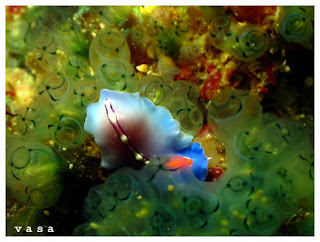Phylum: Porifera
Genus: Aphrocallistes
Species: vastus
Sponges have always been in many seas
since the precambrian. They are major contributors
to reef formations. Are they the sponges we know about
as kids? In a way, yes-- the volume of water
through a sponge can be 20,000x its biological volume in
a 24 hour period! However, many kids grow up
not knowing that sponges have calcareous
skeletons.
This specific sponge is known
as a cloud sponge. To B.C. divers, you can observe them
in our native coasts.
(http://www.youtube.com/watch?v=6bLjNWpUAyU)
 |
Phylum: Porifera
Genus: Stauro
Species: calyptus
These are a textbook example
of a glass sponge, which some people
think they should be part of their phylum.
That spider is pretty. Implies a symbiotic
relationship |
|
|
Phylum: Cnidaria
Genus: Carybdea
Species: sivickisi
Cnidarians require zooxanthellae to rake up
sunlight and help convert their digesting prey.
They have two stages: polyp stage, where
they're attached to the ground firmly and
the medusa stage, where they float freely.
This specific species stings people and is
attracted by both artificial and natural light.
Apparently, the Permian period ended 95% of
all marine species, especially Cnidarians.
|
|
 |
Phylum: Cnidaria
Genus: Metridium
Species: farcimen
These "dandelions of the sea" are
found in places that have low kelp
supplies but a lone one might
pop up in a forest.
 |
Phylum: Cnidarian
Genus: Urticina
Species: piscivora
Abundant on rocks without
kelp forests.
It also eats fish--check it:
http://www.youtube.com/watch?v=ruS2u1-uNko |
|

Phylum: Porifera
Genus: Oceanapia
Species: sagittaria
Another Thailan sponge--Usually
this sponge is seen by itself
or growing on rubble in groups. Water
is exhaled from the sponge.
|
Phylum: Porifera
Genus: Aphrocallistes
Species: vastus
Sponges have always been in many seas
since the precambrian. They are major contributors
to reef formations. Are they the sponges we know about
as kids? In a way, yes-- the volume of water
through a sponge can be 20,000x its biological volume in
a 24 hour period! However, many kids grow up
not knowing that sponges have calcareous
skeletons.
This specific sponge is known
as a cloud sponge. To B.C. divers, you can observe them
in our native coasts.
(http://www.youtube.com/watch?v=6bLjNWpUAyU)
 |
Phylum: Porifera
Genus: Stauro
Species: calyptus
These are a textbook example
of a glass sponge, which some people
think they should be part of their phylum.
That spider is pretty. Implies a symbiotic
relationship
|
|
|


No comments:
Post a Comment